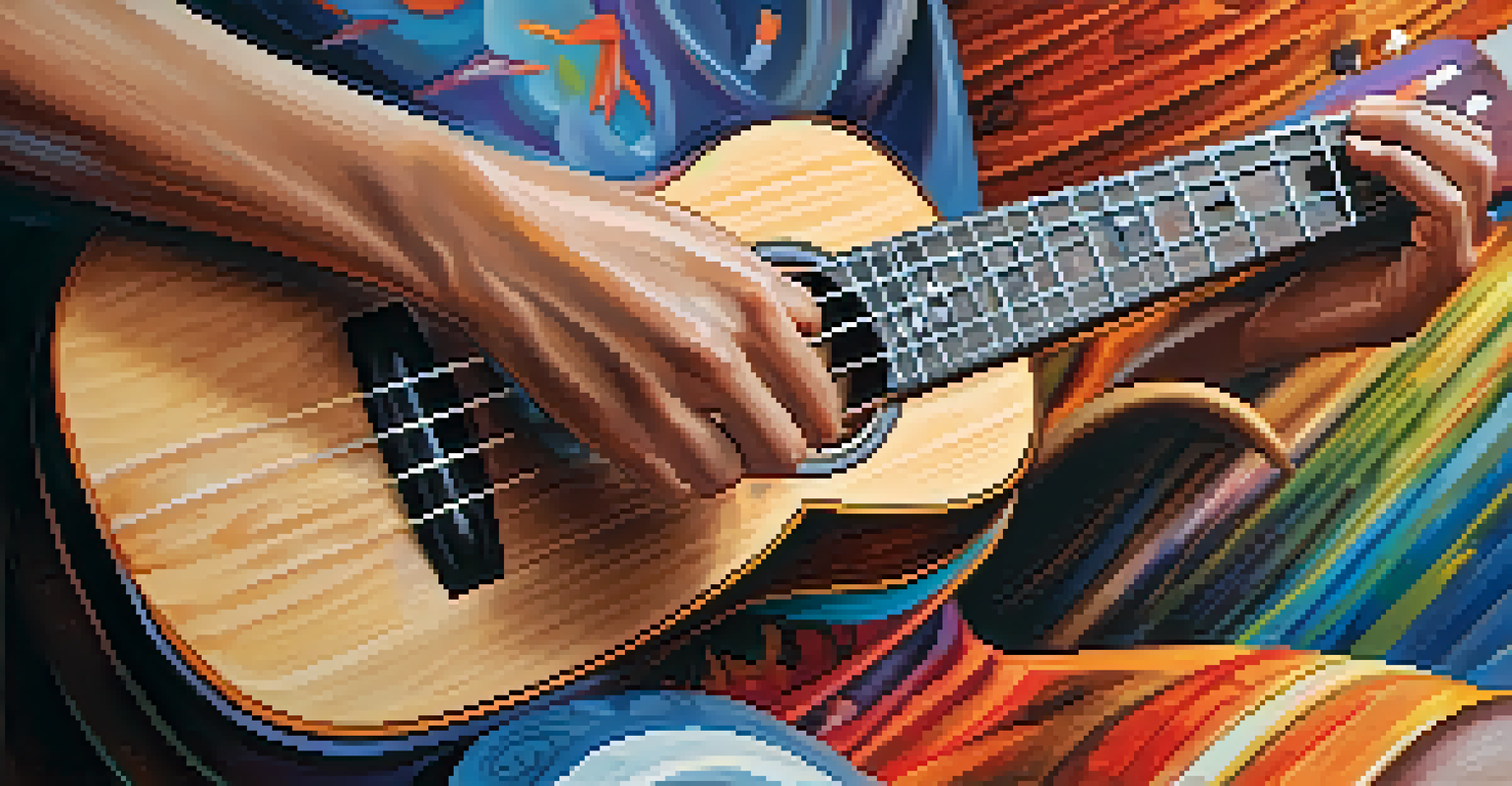Exploring the I-IV-V Chord Progression in Ukulele Songs

Understanding the I-IV-V Chord Progression
The I-IV-V chord progression is a foundational element in many songs, especially in genres like pop, rock, and folk. In the key of C, for example, the I chord is C, the IV chord is F, and the V chord is G. This simple yet powerful trio creates a pleasing musical structure that’s easy for beginners to grasp.
Music is the shorthand of emotion.
Think of the I-IV-V progression as the building blocks of a song. Just like how a sandwich requires bread, filling, and condiments, music relies on these chords to create harmony. Whether you’re strumming along to a favorite tune or crafting your own, understanding this progression opens up a world of musical possibilities.
Many popular songs utilize this progression, making it a staple for aspiring musicians. Songs like 'Twist and Shout' and 'La Bamba' showcase the catchy and memorable sound that comes from using these chords. By mastering the I-IV-V progression, you can play along with many of your favorite ukulele songs.
Why the I-IV-V Progression is So Popular
The popularity of the I-IV-V chord progression can be attributed to its simplicity and versatility. Musicians across various genres have adopted it because it allows for easy transitions and creates a familiar sound. This familiarity encourages sing-alongs and makes it approachable for both players and listeners.

Moreover, the emotional impact of this progression can’t be overlooked. It strikes a balance between resolution and tension, evoking feelings that resonate with audiences. Just like the plot of a good story, the build-up and release keep listeners engaged and wanting more.
I-IV-V: A Musical Foundation
The I-IV-V chord progression is essential for beginners, providing a simple yet versatile structure used in countless songs.
As a result, many songwriters gravitate towards this chord sequence when crafting new tunes. The ability to create catchy hooks and memorable melodies often leads to successful songs that stand the test of time. So, if you’re looking to write your own music, starting with I-IV-V is a smart choice.
Common Ukulele Songs Using I-IV-V Progression
Several well-known songs feature the I-IV-V chord progression, making them perfect for ukulele players to learn. Classics like 'You Are My Sunshine' and 'Stand By Me' showcase this progression beautifully. By playing these songs, you can practice and get comfortable with the chords while having fun.
The beautiful thing about learning is that no one can take it away from you.
Additionally, contemporary hits like 'With a Little Help from My Friends' also utilize this progression. This shows that the I-IV-V isn’t just a relic of the past but remains relevant in today’s music scene. Learning these songs can enhance your playing and keep your practice sessions exciting.
Remember, each song may use variations or different strumming patterns, but the essence remains the same. As you explore these tracks, you’ll find that the I-IV-V progression is not only a teaching tool but also a bridge connecting generations of music lovers.
Tips for Practicing the I-IV-V Progression
When practicing the I-IV-V chord progression on the ukulele, start by familiarizing yourself with each chord individually. Spend a few minutes on each chord, ensuring your fingers are positioned correctly and that you’re getting a clean sound. This foundational step is key to playing smoothly when transitioning between chords.
Next, practice switching between the chords in a slow and deliberate manner. Use a metronome to keep a steady tempo, gradually increasing your speed as you become more comfortable. This approach not only builds muscle memory but also enhances your overall rhythm.
Emotional Impact of Chords
This progression balances resolution and tension, making it emotionally engaging for both musicians and audiences.
Finally, try strumming along to your favorite songs that use the I-IV-V progression. This not only makes practice enjoyable but also reinforces what you’ve learned. As you play along, you'll start to feel the music and discover your unique style.
Exploring Variations of the I-IV-V Progression
Once you’ve mastered the basic I-IV-V progression, consider exploring variations to add depth to your playing. For example, you can experiment with adding seventh chords, like C7 or G7, to create a richer sound. These chords introduce a bit of tension that can enhance the emotional quality of your music.
Another way to vary the progression is by changing the order of the chords. Instead of sticking strictly to I-IV-V, try using V-IV-I or IV-I-V to see how it changes the feel of the song. This experimentation can lead to unique compositions that reflect your personal style.
Lastly, don’t hesitate to incorporate different strumming patterns or fingerpicking techniques. These subtle changes can transform a familiar progression into something fresh and exciting. The key is to keep experimenting and finding what resonates with you.
The Role of Rhythm in I-IV-V Progressions
Rhythm plays a crucial role in how the I-IV-V progression is perceived. A simple change in strumming pattern can make the same chords feel entirely different. For example, a steady down-up strumming can give a laid-back vibe, while a more intricate pattern can add energy and excitement.
Consider how different musical genres utilize rhythm to evoke various emotions. In reggae, for instance, the offbeat strumming creates a relaxed, danceable feel, while in rock, a driving, straight rhythm can pump up the energy. Understanding how rhythm interacts with the I-IV-V progression can greatly enhance your musical expression.
Rhythm Enhances Expression
Altering rhythm and strumming patterns can significantly change the feel of the I-IV-V progression, allowing for personal expression.
As you practice, pay attention to how different rhythms affect the songs you play. Experiment with your own patterns to see what feels right for you. This exploration can lead to powerful performances that truly connect with your audience.
Final Thoughts on the I-IV-V Chord Progression
The I-IV-V chord progression is more than just a collection of chords; it’s a gateway to creativity and musical exploration. By understanding and practicing this progression, you open yourself up to a vast repertoire of songs and styles. It’s a fundamental skill that every ukulele player should embrace.
As you continue your musical journey, remember that the I-IV-V progression can serve as a solid foundation for your own compositions. Don’t be afraid to add your unique twist or style to make it your own. After all, music is all about personal expression and creativity.

Whether you’re strumming along with friends or performing solo, the I-IV-V progression will always be a reliable companion. So grab your ukulele, start experimenting, and enjoy the beautiful world of music that awaits you!